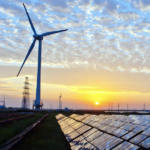One of the most hopeful statistics regarding the world’s energy goals comes from the U.S. Department of Energy’s National Renewable Energy Laboratory, whose study explained that it’s possible for America to generate 80% of its electricity from renewable energy by 2050. Countries “going it alone” is the wrong approach for successfully addressing global warming. U.S. companies can achieve this but need to meet with people and organizations that are actively achieving these goals.
For U.S. Companies, Collaboration Is the Way Forward
American companies wishing to adopt the most-effective versions of renewable technologies can look to Europe as a laboratory for how to transition to renewable forms of energy. U.S. companies and organizations are finding a receptive audience there for sharing knowledge and partnering on energy projects, boosted by the fact that many of the nations that are the most advanced in their reliance on renewables are located in Europe.
A typical example of such an alliance is the new research hub in Dublin, Ireland, established by the California-based Electric Power Research Institute (EPRI), which will spearhead an array of smart grid research projects in tandem with Irish researchers and utilities. Meanwhile, Europe’s DERlab (Distributed Energy Resources Lab) in Kassel, Germany, serves as a global research and testing center to perform knowledge transfer for the latest smart grid and distributed energy generation solutions.
Europe Sets a Good Example
U.S. firms looking for a workshop on how to use renewables are studying Scotland, which receives 74% of its electric energy from renewable sources. Scotland generated enough wind energy to power all its homes twice in the first half of 2019, with its overall broad use of several renewable technologies helping to make up about a quarter of the UK’s total renewable generation. Meanwhile, Germany managed to produce 85% of its electricity needs from renewables on one occasion back in 2017. Today, it has a strong reliance on renewable energy.
Scandinavian countries are notable for their environmental commitment, with Denmark getting 74% of its energy from renewable sources. That nation leads the way in the use of wind energy, which provides 41% of the nation’s overall electricity. In second place in Europe is Ireland, who’s rapidly growing wind farm sector meets 28% of overall demand, according to the WindEurope association.
Joining Forces Across the Pond
Part of the collaboration required to achieve the goal of carbon neutrality is not just for countries to combine their forces, but to form alliances among industry, government, academia, and research organizations. For example, the Energy Institute at University College Dublin (UCD) collaborates with industry on research and seeking funding opportunities, including non-Irish operations located in the country. When we spoke to Claire Cullen, manager of UCD Energy Institute, she told us that the Energy Institute is working with a variety of American companies that include Smart Wires, based in Union City, California.
Smart Wires’ technology allows electricity companies to quickly route power around the existing grid, thus reducing the need for new lines. Having received support from the Irish government, Smart Wires opened a European headquarters in 2018 in Dublin, where engineers are working to reinvent the power grid. In addition, the company is now experiencing its fastest growth globally in the European market.
It’s Not All Hot Air
Wind energy production—onshore and offshore—has been on a roll in Europe, currently providing 14% of the EU’s power. Currently, the largest operational offshore wind farm in the world is located in the UK. An ambitious project called DS3 that is focusing funding and multi-disciplinary research into reinventing the electric grid in Ireland and Northern Ireland so that it runs on renewables, largely wind power.
When we spoke to Jon O’Sullivan, manager of innovation at EirGrid, Ireland’s electric utility, he said that the DS3 project has received outside attention because it’s being viewed “as a blueprint for what has to happen to an electricity system anywhere in the world if you want to decarbonize at scale.” Starting in 2000 with virtually no wind-produced energy, the island quickly ramped up, with a current goal of 40% of electricity coming from wind by 2020, with expectations of getting close or meeting this objective. Sullivan told us that up to 65% of variable energy can now be handled on the grid at any time. He said that there was “simply no system in the world with 65% of the whole system coming from wind today.”
Amazon just announced it will get all its energy from renewable sources at its Irish operations by 2022, doing so by developing an additional wind farm there. The company already ranks first in the U.S. for the amount of solar energy installations that are up and running, and is marching toward running 100% on renewables worldwide.
In studying the experiences of the many European nations that are successfully transitioning to renewable technologies, U.S. companies can access leading-edge, innovative—and proven—ways to shift from conventional energy to green energy investments. ■
—Maeve Cowley is a vice president of Emerging Business with IDA Ireland, a non-commercial, semi-state body promoting foreign direct investment into Ireland.









